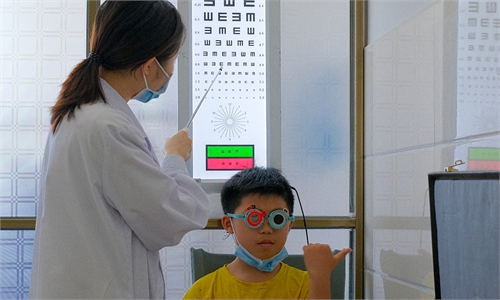IN-DEPTH / IN-DEPTH
Chinese physique continues to improve as governmental, social and marketing efforts grow
Stronger, healthier future
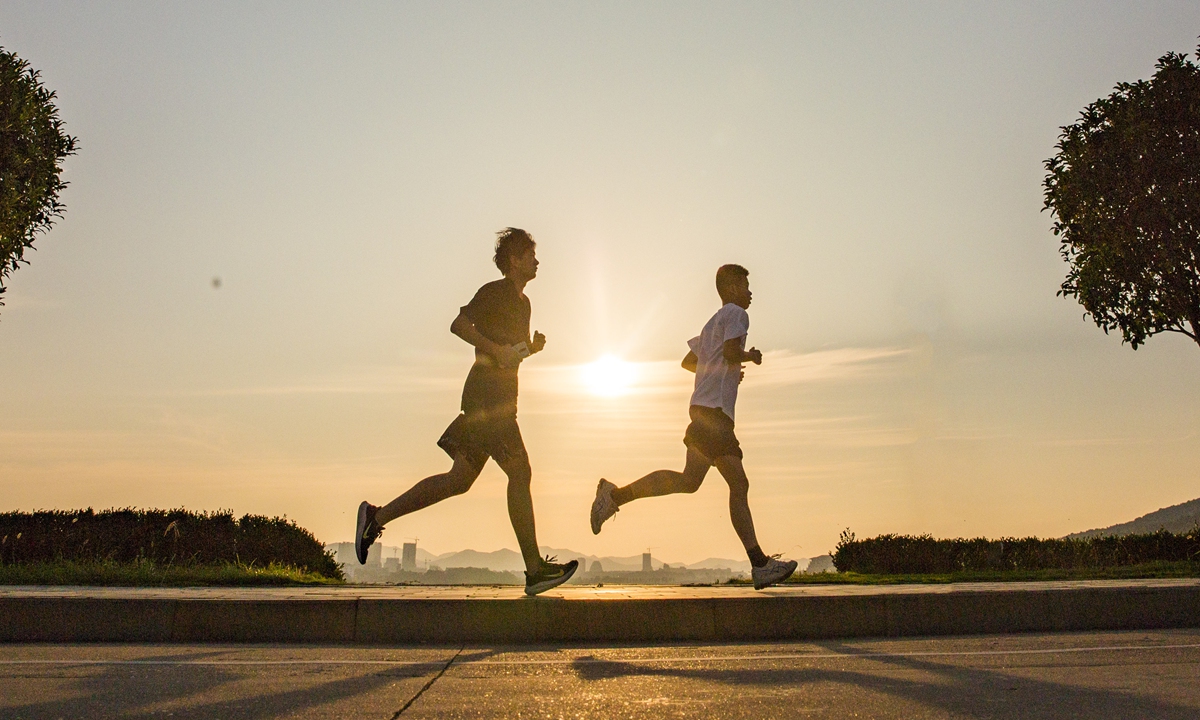
Morning fitness enthusiasts run against the rising sun at Nanshan Park in Jiujiang, East China's Jiangxi Province on June 23. Photo:VCG
The 14th National Games held in Northwest China's Shaanxi, the first major comprehensive sports event in China since the outbreak of the pandemic, closed its doors on September 27 with an achieved goal of "zero infections," something that the Tokyo Olympics Games failed to fulfill."Chinese sports have witnessed the great leap of the Chinese nation from rising up and becoming rich, to becoming strong," Liu Guozhong, the secretary of the Communist Party of China (CPC) Shaanxi Provincial Committee, said at the opening ceremony of the sports gala on September 15.
Liu's remarks would have been unthinkable in poor and weak China 100 years ago. In the early 20th century, the West once used the discriminatory and insulting term "Sick Man of Asia" to describe China's physical weakness.
Late Chinese leader Mao Zedong, published an article in Chinese literary magazine La Jeunesse (The New Youth) on April 1, 1917, expressing his deep concern over the inadequacy of the Chinese physique. In 1941, during the Yan'an period of the CPC, Mao wrote an inscription for the sports special issue of the Liberation Daily: "Develop sports and improve the people's physique."
Today's China is approaching the expectations of the ancestors. Under the guidance of national policies over past decades, especially after the reform and opening-up movement, people's understanding of physical exercise has gradually deepened and enthusiasm has largely increased. China is steadily moving toward becoming a behemoth in sports.
In June 1995, the State Council issued the "Outline of the National Fitness Program" (1995-2010). Two months later, the National People's Congress Standing Committee adopted the Sports Law of China.
Aside from regular surveys and monitoring of citizens' physical data, China has implementing a five-year plan on physical health, according to the National Fitness Program. In October 2017, Chinese President Xi Jinping announced the implementation of the Healthy China Initiative in his report to the 19th CPC National Congress. In 2019, the State Council issued a new guideline to implement the Healthy China Initiative and promote people's health.
Since the "double reduction" policy announced on July 24, the burden of homework and excessive after-school study hours are to be reduced. Besides, the social? and financial development of the sports and health industries are more diversified and comprehensive as well.
'Hobby days'
The dramatic changes are most pronounced among students.
According to the 8th edition of the national survey on students' physique and health released by the Ministry of Education (MOE) on September 3, the ratio of students aged 6-22 reaching the standard of excellent physical health was 23.8 percent, showing a rising trend
Incidentally, the height, weight, chest circumference and other morphological development indicators of primary and secondary school students continued to improve, and lung capacity rose in an all-round way. Flexibility, strength, speed, endurance, and other qualities have also improved. Malnutrition rate continued to decline.
"Our government has always advocated taking exercise for one hour a day. After the 'double reduction' policy was announced, we have enriched the activities and more students continue to take part," Zhao Yufeng, the principal of Yuxin School attached to Capital Normal University in Beijing's Changping district, told the Global Times.
Zhao said that the school offers 105 after-school activities for its primary and secondary school students, including volleyball, the school's strongest game.
"Parents and students choose projects after school ends at 3:30 pm, of their own free will… Activities on Monday, Wednesday and Friday are culture-related. Tuesdays and Thursdays are hobby days, and students are expected to take part in all club activities including sports," Zhao said.
According to the goal in the Healthy China Initiative, in 2022, more than 70 percent of school sports venues and facilities should be open, with per capita sports area at 1.9m2 square meters or above.
Zhao said as a school with sports characteristics, they also offer weekend training services, which is called "5+X."
"Five-day routines may not be enough for some talented and interested students. They may want to participate in more sports training on weekends, so the 'X' depends on their own needs," Zhao said.
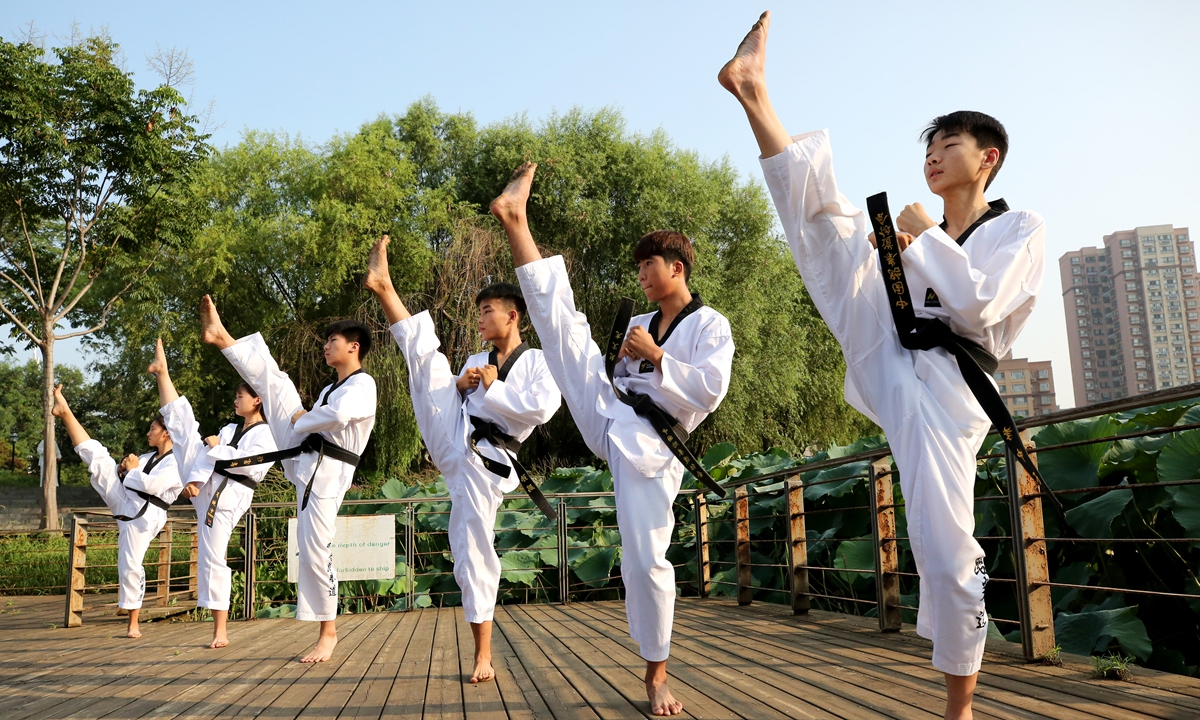
Young taekwondo enthusiasts practice the martial art at Xishahe Park in Zaozhuang, East China's Shandong Province on August 8. Photo:IC
Since 2015, the MOE has launched a nationwide campaign to build schools with sports characteristics, which has played a positive role in improving students' physique and health.With the increase of physical examination score in high school entrance exams, secondary school students have increased their physical activities, as 42.7 percent of junior middle school students did one hour of physical exercise per day, according to MOE's latest data.
The MOE also stressed that physical education should be taken as an important indicator in the school evaluation system. The ministry said it will continue to put emphasis on physical education and extracurricular exercises, and encourage students to leave the classroom for sports.
Once and always
"I think I'm playing a role as a communicator of social sports. For the sports training of kids, it will be subject to a limit for various reasons in school. For example, dozens of children may train at the same time in one venue, so they may not get detailed guidance," Miao Le, the founder of a football academy named Xiangdong in Beijing, told the Global Times.
After graduation from the Beijing Sport University, Miao worked as a coach in a sports school. In 2013, he founded the Xiangdong football club, which was one of the first members of Beijing Football Association, with coaches that are mostly young people accredited with AFC coaching certificates.
"The kids apply what they learn on the field, gradually developing confidence - a kind of personality development - which is a complement to after-class activities," Miao said.
Cai Yuanpei, an educator and head of Peking University in the 1920s, has a famous saying which goes "sports' ranks the first in forming [a] complete personality." Miao takes the words as his motto.
Through football matches or training, kids can directly learn skills such as respect for opponents, abiding by the rules, and unity and cooperation, Miao said.
"If a child can enjoy a sport from an early age, it can last a lifetime. There are many middle-aged people still playing football, not from an athletic perspective, but because love and joy," Miao said.
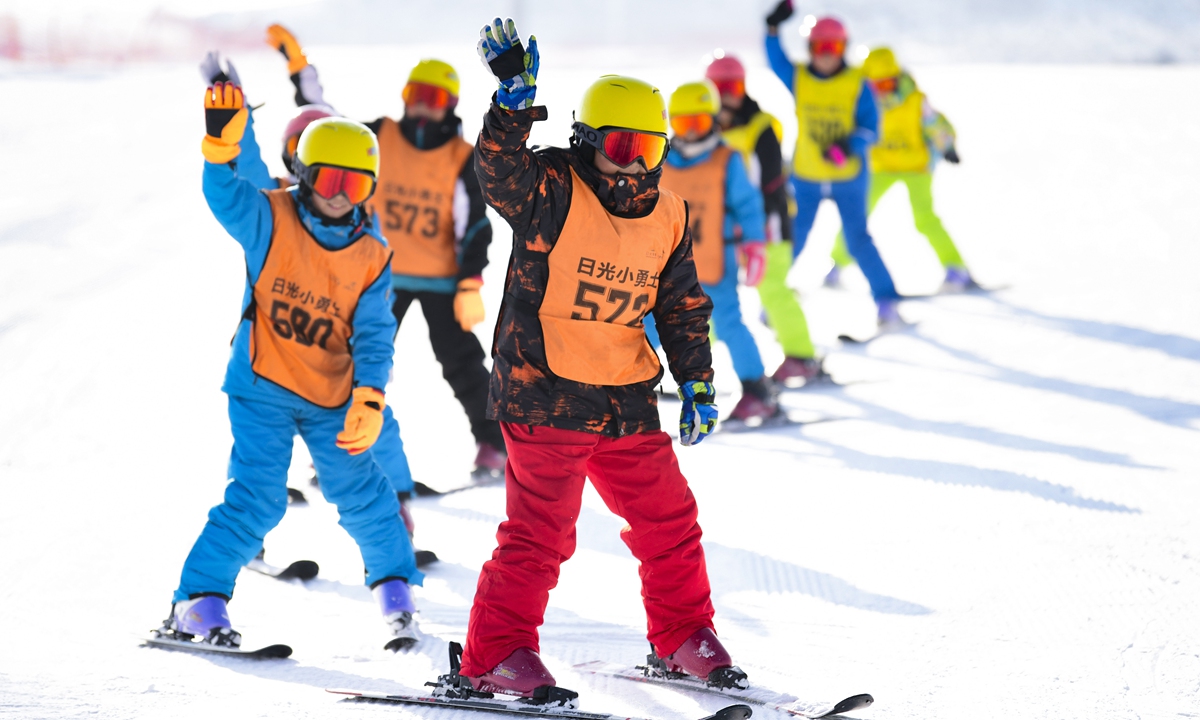
Students from Gongnonglu Primary School in Ulanqab of North China's Inner Mongolia Autonomous Region ski at a resort on December 22, 2020. Photo:VCG
With the encouragement and support of the government in recent years, sports training has become increasingly formal, and more children choose to attend physical classes instead of early exposure to math and English, which may be a little boring for them.Miao recalled that when the club was founded, the children that came for training were usually 8 or 9 years old. In recent years, more and more 4 and 5 year-olds are signed up.
"There are more than 100 children under 8 in our club, or, more than half of our kids," Miao said, adding that "these kids, who were introduced to sports at an earlier age, are much more physically and athletically capable than those who start training at 8 and 9 years old."
"When our club was founded, sending children to sports training was a small business in China… Nowadays, most of our kids' parents were born in the 1980s and 1990s. They may not have had the chance to play football often when they were young, but most of them are football fans," Miao said.
They (parents) know that sports are good. Even if they don't send their children to football club, they will sign up for other sports classes, such as swimming and tennis… Now there are more choices and more demand, Miao said.
Surnamed Ren, the father of a 6-year-old boy who plays football at Miao's academy, told the Global Times that the main purpose in sending his son to play football is to improve physical fitness and to have fun.
"My son is not the shortest in his class, but he was found to be the lightest in his physical examination last year… Now his kindergarten has several children who often have online classes found to have myopia," Ren said.
"If my son plays as much as he likes at this age, he may be more focused on learning when he goes to school. If we enroll him in various classes from kindergarten on, he may be rebellious when he goes to middle school," Ren said.
Best is yet to come
During the period of 13th Five-Year Plan (2016-20), 37.2 percent of Chinese people took part in regular physical exercise, government data show.
According to the goal of the nationwide physical fitness plan (2021-25) released in August, the proportion of people who regularly take part in physical exercise is expected to reach 38.5 percent by 2025.
That aside, more than 2,000 public facilities including sports parks, national fitness centers and public stadiums will be built or renovated, and more than 5,000 units of public fitness equipment will be refurbished.
Reporters found that in Beijing most of the old residential communities have installed or have been fitted with fitness equipment, and most of the new communities were constructed with exercise equipment included, and always had gyms nearby.
By 2025, the total volume of China's sports industry is aimed to reach 5 trillion yuan ($773 billion).
Some experts believe that the COVID-19 epidemic has reminded people of the importance of fitness once again. When the national level of physical fitness is greatly improved, public expenditure on medical treatment will be greatly reduced. As China is approaching the goal of reaching the level of other moderately developed countries in terms of per capita GDP by 2035, the sports and health industry will be more vigorous in the future.
According to the 2020 China Fitness Industry Data Report released in March, about 70.3 million people have a gym membership, with more than 44,000 fitness clubs and 900,000 professional fitness trainers.
A Beijing-based fitness practitioner surnamed Shi told the Global Times that the public's enthusiasm for workout has increased, and that fitness habits have become more scientific in the past few years.
The expansion of the fitness population is also related to the rise in people's income levels, Shi said. "In previous years, China's main fitness population was concentrated in large cities, but in recent years, more people in second- and third-tier cities have begun to know and invest in fitness, and people are more willing to use their spare time on sports."
"In the past, many people trained casually without scientific consideration, but in recent years, it can be seen that most people who come to the gym have a more scientific training plan," Shi said.
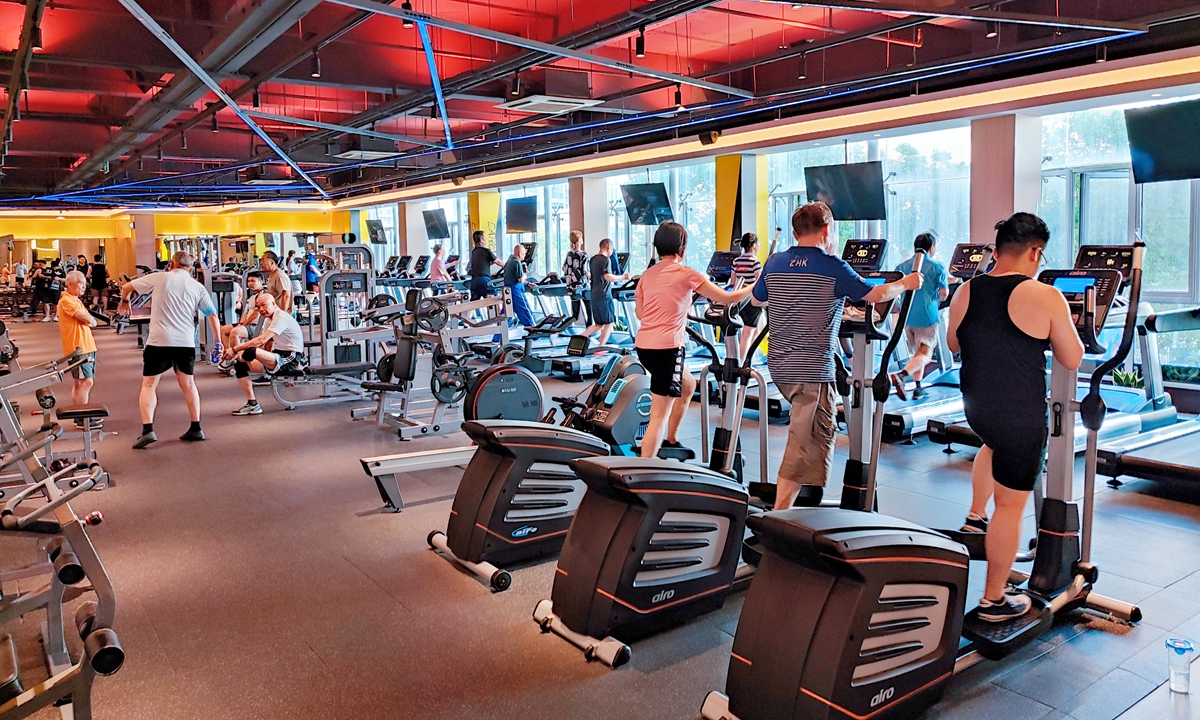
A gym in Shanghai bustling with activity on June 20. Photo:VCG
China's current population also has a greater potential for the development of fitness, and it is expected that with further progress of national sports awareness, more residents will join in fitness. Currently, the college student population is the most promising development group, Shi noted.Young generations in China have now taken to a variety of forms in exercise and relaxation. To them, they are more of a lifestyle and attitude of living rather than merely working out the body.
V5 Dance Club, a modern dance training center founded in 2012 in Beijing, has expanded its branches to three in the busiest commercial sectors across the Chinese capital and have been seeing a surge by multiple digits in the number of sign-ups compared with previous years.
"Most of our members are young females from college students or company employees. They started out wanting to work out their bodies, but then gradually, becoming so 'obsessed' with the dances and rhythms that many of them come almost every day," a staff at the dance club surnamed Kong told the Global Times.
"It is a good way to relax and get some mental yoga done for the strained brain. People dance, sing, or even shout out in a carefree way during our classes and they find themselves relieved from the pressures of life. I believe it is more of a positive attitude toward life that reflects the energy and spirit of today's young people," she said.

